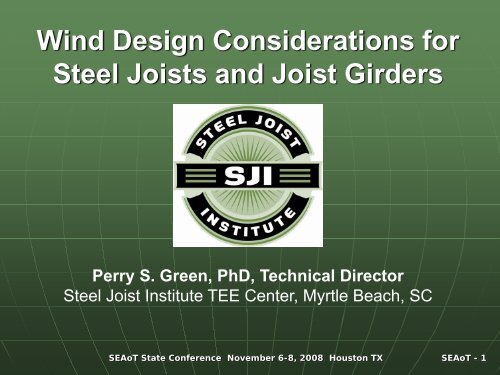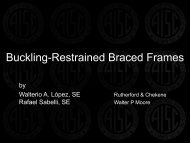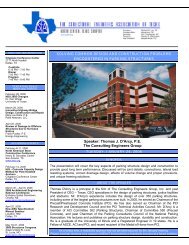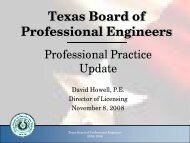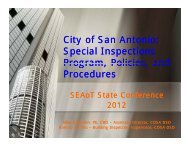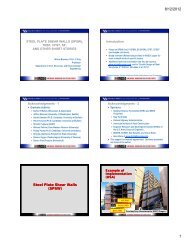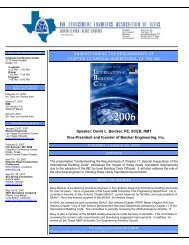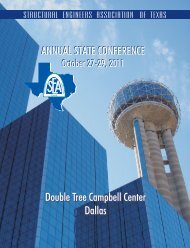Wind Design Considerations for Steel Joists and Joist Girders - SEAoT
Wind Design Considerations for Steel Joists and Joist Girders - SEAoT
Wind Design Considerations for Steel Joists and Joist Girders - SEAoT
Create successful ePaper yourself
Turn your PDF publications into a flip-book with our unique Google optimized e-Paper software.
Introduction‣ Commercial manufacture of open websteel joists began in 1923‣ The <strong>Steel</strong> <strong>Joist</strong> Institute was <strong>for</strong>med in1928• The use of steel joists has continued togrow year after year <strong>for</strong> both floors <strong>and</strong>roofs.• Millions of steel joists <strong>and</strong> <strong>Joist</strong> <strong>Girders</strong>are put in service each year.<strong>SEAoT</strong> State Conference November 6-8, 2008 Houston TX <strong>SEAoT</strong> - 2
General Nature of <strong>Wind</strong> LoadsTypical <strong>Steel</strong> <strong>Joist</strong> <strong>and</strong> <strong>Joist</strong> Girder Buildings• <strong>Wind</strong>storms• Building type – commercial, industrial• Building shape – low rise, rectangular• Roofing systems<strong>SEAoT</strong> State Conference November 6-8, 2008 Houston TX <strong>SEAoT</strong> - 3
<strong>Wind</strong>storm Damage to Roof in Texas05 March 2004<strong>SEAoT</strong> State Conference November 6-8, 2008 Houston TX <strong>SEAoT</strong> - 4
<strong>Wind</strong>storm Damage to Roof in Texas05 March 2004<strong>SEAoT</strong> State Conference November 6-8, 2008 Houston TX <strong>SEAoT</strong> - 5
Hurricane Charley Category 4 StormAcross Florida 13-14 August 2004<strong>SEAoT</strong> State Conference November 6-8, 2008 Houston TX <strong>SEAoT</strong> - 6
Hurricane Charley Category 4 StormAcross Florida 13-14 August 2004<strong>SEAoT</strong> State Conference November 6-8, 2008 Houston TX <strong>SEAoT</strong> - 7
Population Trends in Hurricane-Prone Regions of the U.S.• Southeast <strong>and</strong> Gulf of Mexico: Most rapidcoastal growth in recent decades <strong>and</strong> willcontinue to grow.• Southeast: 8 million (1960) 23 millionprojected (2015)• Gulf of Mexico: 8 million (1960) 22 millionprojected (2015)<strong>SEAoT</strong> State Conference November 6-8, 2008 Houston TX <strong>SEAoT</strong> - 8
Top 10 Deadliest Hurricanes toStrike the US: 1851-20059,0008,0007,0006,0005,0004,0003,0002,0001,0000LA-Gr<strong>and</strong>e Isle (1909)Footnotes:*Could be as high as 12,000.**Could be as high as 3,000.***Midpoint of 1,000 – 2,000 range.****AP total as of Dec. 11, 2005.*****Midpoint of 1,100-1,400 range.Sources: NOAA; InsuranceIn<strong>for</strong>mation Institute.372 390 400 408Audrey-SW LA,TX (1957)LA-Last Isl<strong>and</strong> (1856)FL Keys (1935)GA/SC (1881)700LA-Cheniere (1893)*****Hurricane Katrinawas the deadliesthurricane to strikethe US since 19281,250 1,323 1,500Katrina (SE LA, MS)****SC/GA Sea Isl<strong>and</strong>s (1893)***SE FL/L. Okechobee (1928)**2,500Galvaston (1900)*8,000<strong>SEAoT</strong> State Conference November 6-8, 2008 Houston TX <strong>SEAoT</strong> - 9
Roof <strong>Design</strong> to Resist Uplift Loads• Codes <strong>and</strong> St<strong>and</strong>ards• 2005 SJI St<strong>and</strong>ard Specifications <strong>and</strong> Code ofSt<strong>and</strong>ard Practice• Provisions from 2006 International Building Code• Provisions from ASCE/SEI 7-05• <strong>Design</strong> of <strong>Joist</strong> Bearing Seats• <strong>Design</strong> Example - Placement of <strong>Joist</strong> Bridging• Summary <strong>and</strong> Conclusions<strong>SEAoT</strong> State Conference November 6-8, 2008 Houston TX <strong>SEAoT</strong> - 10
Roof <strong>Design</strong> to Resist Uplift LoadsThe nominal loads <strong>and</strong> load combinations shall beas stipulated by the applicable code under whichthe structure is designed, <strong>and</strong> as shown by theSpecifying Professional in the contract documents.In the absence of a specified building code such asthe International Building Code (IBC 2006), theASCE/SEI 7-05 (ASCE 2005) “Minimum <strong>Design</strong>Loads <strong>for</strong> Buildings <strong>and</strong> Other Structures” shall beused as the basis <strong>for</strong> the loads <strong>and</strong> loadcombinations.<strong>SEAoT</strong> State Conference November 6-8, 2008 Houston TX <strong>SEAoT</strong> - 12
2005 SJI St<strong>and</strong>ard Specification <strong>for</strong>Longspan <strong>Steel</strong> <strong><strong>Joist</strong>s</strong>, LH-SeriesDeep Longspan <strong>Steel</strong> <strong><strong>Joist</strong>s</strong>, DLH-Series104.12 UPLIFTWhere uplift <strong>for</strong>ces due to wind are a design requirement, these<strong>for</strong>ces must be indicated on the contract drawings in terms ofNET uplift in pounds per square foot (Pascals). The contractdocuments shall indicate if the net uplift is based upon LRFD orASD. When these <strong>for</strong>ces are specified, they must be consideredin the design of joists <strong>and</strong>/or bridging. A single line of bottomchord bridging must be provided near the first bottom chordpanel points whenever uplift due to wind <strong>for</strong>ces is a designconsideration.*<strong>SEAoT</strong> State Conference November 6-8, 2008 Houston TX <strong>SEAoT</strong> - 15
2005 SJI St<strong>and</strong>ard Specification <strong>for</strong><strong>Joist</strong> <strong>Girders</strong>1004.9 UPLIFTWhere uplift <strong>for</strong>ces due to wind are a design requirement, these<strong>for</strong>ces must be indicated on the contract drawings in terms ofNET uplift in pounds per square foot (Pascals). The contractdrawings must indicate if the net uplift is based on ASD orLRFD. When these <strong>for</strong>ces are specified, they must beconsidered in the design of <strong>Joist</strong> <strong>Girders</strong> <strong>and</strong>/or bracing. If theends of the bottom chord are not strutted, bracing must beprovided near the first bottom chord panel points wheneveruplift due to wind <strong>for</strong>ces is a design consideration.*<strong>SEAoT</strong> State Conference November 6-8, 2008 Houston TX <strong>SEAoT</strong> - 16
2005 SJI Code of St<strong>and</strong>ard Practice1.4 DESIGNIn the absence of ordinances or specifications to the contrary,all designs prepared by the specifying professional shall be inaccordance with the <strong>Steel</strong> <strong>Joist</strong> Institute St<strong>and</strong>ard SpecificationsLoad Tables & Weight Tables of latest adoption.<strong>SEAoT</strong> State Conference November 6-8, 2008 Houston TX <strong>SEAoT</strong> - 17
2005 SJI Code of St<strong>and</strong>ard Practice6.1 PLANS FURNISHED BY BUYER(a) LoadsThe <strong>Steel</strong> <strong>Joist</strong> Institute does not presume to establish theloading requirements <strong>for</strong> which structures are designed.The <strong>Steel</strong> <strong>Joist</strong> Institute Load Tables are based on uni<strong>for</strong>mloading conditions <strong>and</strong> are valid <strong>for</strong> use in selecting joist sizes<strong>for</strong> gravity loads that can be expressed in terms of "pounds perlinear foot" (kiloNewtons per Meter) of joist. The <strong>Steel</strong> <strong>Joist</strong>Institute <strong>Joist</strong> Girder Weight Tables are based on uni<strong>for</strong>mlyspaced panel point loading conditions <strong>and</strong> are valid <strong>for</strong> use inselecting <strong>Joist</strong> Girder sizes <strong>for</strong> gravity conditions that can beexpressed in kips (kiloNewtons) per panel point on the <strong>Joist</strong>Girder.<strong>SEAoT</strong> State Conference November 6-8, 2008 Houston TX <strong>SEAoT</strong> - 18
2005 SJI Code of St<strong>and</strong>ard Practice6.1 PLANS FURNISHED BY BUYER(a) Loads (cont’d)The specifying professional shall give due consideration to thefollowing loads <strong>and</strong> load effects:1. Ponded rain water.2. Accumulation of snow in the vicinity of obstructions suchas penthouses, signs, parapets, adjacent buildings, etc.3. <strong>Wind</strong>.4. Type <strong>and</strong> magnitude of end moments <strong>and</strong>/or axial <strong>for</strong>cesat the joist <strong>and</strong> <strong>Joist</strong> Girder end supports shall be shownon the structural drawings. For moment resisting joists or<strong>Joist</strong> <strong>Girders</strong> framing near the end of a column, dueconsideration shall be given to extend the column lengthto allow a plate type connection between the top of thejoist or <strong>Joist</strong> Girder top chord <strong>and</strong> the column.<strong>SEAoT</strong> State Conference November 6-8, 2008 Houston TX <strong>SEAoT</strong> - 20
St<strong>and</strong>ards <strong>and</strong> Codes• 2005 SJI St<strong>and</strong>ard Specifications <strong>and</strong> Codeof St<strong>and</strong>ard Practice• Provisions from 2006 InternationalBuilding Code• Provisions from ASCE/SEI 7-05<strong>SEAoT</strong> State Conference November 6-8, 2008 Houston TX <strong>SEAoT</strong> - 21
2006 International Building Code• SECTION 1605 LOAD COMBINATIONS• 1605.2 Load combinations using strengthdesign or load <strong>and</strong> resistance factor design1605.2.1 Basic load combinations1.2D + 1.6(L r or S or R) + (f 1 L or 0.8W)1.2D + 1.6W + f 1 L + 0.5(L r or S or R)0.9D + 1.6W0.9D + 1.0ENOTE: F <strong>and</strong>/or H loads have been left outof the above equations<strong>SEAoT</strong> State Conference November 6-8, 2008 Houston TX <strong>SEAoT</strong> - 23
2006 International Building Code• SECTION 1605 LOAD COMBINATIONS• 1605.3 Load combinations using allowablestress design1605.3.1 Basic load combinationsD + (W or 0.7E)D +0.75 (W or 0.7E) + 0.75L + 0.75(L r or S or R)0.6D + W0.6D + 0.7ENOTE: F <strong>and</strong>/or H loads have been left out ofthe above equations<strong>SEAoT</strong> State Conference November 6-8, 2008 Houston TX <strong>SEAoT</strong> - 24
St<strong>and</strong>ards <strong>and</strong> Codes• 2005 SJI St<strong>and</strong>ard Specifications <strong>and</strong> Codeof St<strong>and</strong>ard Practice• Provisions from 2006 International BuildingCode• Provisions from ASCE/SEI 7-05<strong>SEAoT</strong> State Conference November 6-8, 2008 Houston TX <strong>SEAoT</strong> - 25
ASCE 7-05 Specified <strong>Wind</strong> LoadsBasic parameters• <strong>Wind</strong> speed, importance, exposure• Significance / importance of exposurecategory• Exposure C is “default”, while charts arebased on “B”• The difference is often 30 to 40 percent<strong>SEAoT</strong> State Conference November 6-8, 2008 Houston TX <strong>SEAoT</strong> - 26
ASCE 7-05 Basic <strong>Wind</strong> Speed Map<strong>SEAoT</strong> State Conference November 6-8, 2008 Houston TX <strong>SEAoT</strong> - 27
ASCE 7-05 Specified <strong>Wind</strong> Loads• It all looks simple when the building structureappears to be a simple rectangle made up oflarge monolithic elements as described inFigure 6-3.• The reality is when the building shape is morecomplex comprised of numerous elements thenit is not as easy to determine the loadings onjoists in corners <strong>and</strong> <strong>Joist</strong> <strong>Girders</strong> that passthrough both edge <strong>and</strong> corner zones.<strong>SEAoT</strong> State Conference November 6-8, 2008 Houston TX <strong>SEAoT</strong> - 28
ASCE 7-05 Specified <strong>Wind</strong> Loads<strong>SEAoT</strong> State Conference November 6-8, 2008 Houston TX <strong>SEAoT</strong> - 29
ASCE 7-05 Specified <strong>Wind</strong> Loads<strong>SEAoT</strong> State Conference November 6-8, 2008 Houston TX <strong>SEAoT</strong> - 30
ASCE 7-05 Specified <strong>Wind</strong> LoadsWhat Constitutes Net Uplift?• For ASD,the “uplift” load combination is 0.6D + W• For LRFD,the “uplift” load combination is 0.9D + 1.6WThe EOR may need to differentiate betweenminimum <strong>and</strong> maximum dead load.(Note: 0.6D is NOT an allowance <strong>for</strong> collateral loads)<strong>SEAoT</strong> State Conference November 6-8, 2008 Houston TX <strong>SEAoT</strong> - 31
ASCE 7-05 Specified <strong>Wind</strong> LoadsWhat constitutes Net Uplift?DL1.65( ↓) + WL( ↓)( DL + WL)=0.6F A= F A1.65DL + 1.65WL =Amplified DL resistance by 1.65 <strong>for</strong> uplift is notdesirable!So,DL ↓ + 1.65WL ↑ = F A( ) ( )0.6DL + WL =yyyg0.6F AygF Agygg<strong>SEAoT</strong> State Conference November 6-8, 2008 Houston TX <strong>SEAoT</strong> - 32
ASCE 7-05 Specified <strong>Wind</strong> Loads• Maximum Dead Load (<strong>for</strong> gravity loading)• Minimum Dead Load (<strong>for</strong> wind uplift)• Collateral Load (also <strong>for</strong> wind uplift)Collateral loads represent a category of deadloads which are not part of the building structurebut are required <strong>for</strong> the building’s function.These include: Mechanical equipment, piping,electrical equipment, conduit, sprinkler pipingfire proofing, ceilings, etc.<strong>SEAoT</strong> State Conference November 6-8, 2008 Houston TX <strong>SEAoT</strong> - 33
<strong>Wind</strong> Loads: Net Uplift Zone Diagram8'24 psf80'15 psf11 psf96 plf8'120'60 plf1460 lbs 1228 lbs<strong>SEAoT</strong> State Conference November 6-8, 2008 Houston TX <strong>SEAoT</strong> - 34
Properly Applying <strong>Wind</strong> Loads to<strong>Steel</strong> <strong><strong>Joist</strong>s</strong> <strong>and</strong> <strong>Joist</strong> <strong>Girders</strong>• The chart on the following slide is atypical components <strong>and</strong> cladding roofwind pressures chart provided on thecontract documents.• Roof pressure needs to be converted toNET uplift, or more correctly the result ofthe appropriate load combination <strong>for</strong> wind<strong>for</strong>ces acting upward.<strong>SEAoT</strong> State Conference November 6-8, 2008 Houston TX <strong>SEAoT</strong> - 36
Properly Applying <strong>Wind</strong> Loads to<strong>Steel</strong> <strong><strong>Joist</strong>s</strong> <strong>and</strong> <strong>Joist</strong> <strong>Girders</strong>ROOF SURFACESEFFECTIVEWIND AREAPOSITIVE PRESSURES(PSF)ZONENEGATIVE PRESSURES(PSF)1 2 3 1 2 310 SF 5.3 5.3 5.3 -13.0 -21.8 -32.820 SF 5.0 5.0 5.0 -12.7 -19.5 -27.250 SF 4.5 4.5 4.5 -12.2 -16.4 -19.7100 SF 4.2 4.2 4.2 -11.9 -14.1 -14.1<strong>SEAoT</strong> State Conference November 6-8, 2008 Houston TX <strong>SEAoT</strong> - 37
Properly Applying <strong>Wind</strong> Loads to<strong>Steel</strong> <strong><strong>Joist</strong>s</strong> <strong>and</strong> <strong>Joist</strong> <strong>Girders</strong>• Per ASCE definition of Effective Width, takespan times an effective width that is not lessthan one third the span.Note: This is specifically referenced <strong>for</strong> the ASCEMethod 2 charts, but it should also apply to ASCEMethod 1 (simplified).<strong>SEAoT</strong> State Conference November 6-8, 2008 Houston TX <strong>SEAoT</strong> - 38
Properly Applying <strong>Wind</strong> Loads to<strong>Steel</strong> <strong><strong>Joist</strong>s</strong> <strong>and</strong> <strong>Joist</strong> <strong>Girders</strong>• So <strong>for</strong> steel joists, a simple rule is that <strong>for</strong> alljoist spans of 18 foot or greater, use the 100square foot values, i.e. 18 x 6 = 106 > 100 ft. 2• So if a project does not have any spans lessthan 18 feet, there is no need <strong>for</strong> a detailedchart with values by square foot.• The light weight of joists under 18 foot spansoften allows <strong>for</strong> a conservative uplift value tobe used rather than a detailed interpolation <strong>for</strong>the exact square footage.<strong>SEAoT</strong> State Conference November 6-8, 2008 Houston TX <strong>SEAoT</strong> - 39
<strong>Wind</strong> <strong>Design</strong> <strong>Considerations</strong> <strong>for</strong><strong>Steel</strong> <strong><strong>Joist</strong>s</strong> <strong>and</strong> <strong>Joist</strong> <strong>Girders</strong>• Clarifications <strong>and</strong> Interpretations:• ASCE simplified method described in Section6.4.2.2 provides a <strong>for</strong>mula <strong>for</strong> net design windpressure. This is NOT the same as SJIsection 5.11 NET uplift.• ASCE net is the sum of internal <strong>and</strong> externalpressures.• SJI net, is the final resultant pressure, lessappropriate dead load – result of the loadcombination<strong>SEAoT</strong> State Conference November 6-8, 2008 Houston TX <strong>SEAoT</strong> - 41
<strong>Wind</strong> <strong>Design</strong> <strong>Considerations</strong> <strong>for</strong><strong>Steel</strong> <strong><strong>Joist</strong>s</strong> <strong>and</strong> <strong>Joist</strong> <strong>Girders</strong>• <strong>Steel</strong> joists are considered components <strong>and</strong>cladding (C&C).• <strong>Joist</strong> <strong>Girders</strong> are considered Main <strong>Wind</strong> ForceResisting System (MWFRS).Most often, separate MWFRS pressure valuesare not provided <strong>for</strong> the <strong>Joist</strong> <strong>Girders</strong>, <strong>and</strong> thejoist supplier applies the end reaction (net)uplift <strong>for</strong>ces from the component <strong>and</strong> claddingjoists to the girders.Is this conservative?<strong>SEAoT</strong> State Conference November 6-8, 2008 Houston TX <strong>SEAoT</strong> - 42
<strong>Wind</strong> <strong>Design</strong> <strong>Considerations</strong> <strong>for</strong><strong>Steel</strong> <strong><strong>Joist</strong>s</strong> <strong>and</strong> <strong>Joist</strong> <strong>Girders</strong>• Other considerations• Overhangs have significant uplift• TCXs “automatically” have same capacity asdownward gravity.• But uplift on overhangs can easily exceed gravity,particularly in coastal areas or hurricane proneregions.• “Kickers” that carry horizontal wind <strong>for</strong>ces needto have both components defined.<strong>SEAoT</strong> State Conference November 6-8, 2008 Houston TX <strong>SEAoT</strong> - 43
Properly Applying Lateral Loads to<strong>Steel</strong> <strong><strong>Joist</strong>s</strong> <strong>and</strong> <strong>Joist</strong> <strong>Girders</strong>• The first consideration relative to the design of thestructure is to determine if rigid frame action isrequired.• For single story structures the optimum framingsystem generally consists of braced frames in bothdirections, <strong>and</strong> the use of a roof diaphragm systemto transfer wind <strong>and</strong> seismic loads to the verticalbracing elements.• The specifying professional must specify thenecessary loading <strong>and</strong> stiffness data to the joistmanufacturer.<strong>SEAoT</strong> State Conference November 6-8, 2008 Houston TX <strong>SEAoT</strong> - 44
Properly Applying Lateral Loads to<strong>Steel</strong> <strong><strong>Joist</strong>s</strong> <strong>and</strong> <strong>Joist</strong> <strong>Girders</strong>• The specifying professional must indicate the typeof joist to column connections so that the joistmanufacturer can provide the joists with thegeometry that meets the design intent.• The joist manufacturer must design the joists incon<strong>for</strong>mance with the SJI Specifications <strong>and</strong> othercontract requirements specified by the specifyingprofessional.<strong>SEAoT</strong> State Conference November 6-8, 2008 Houston TX <strong>SEAoT</strong> - 45
Properly Applying Lateral Loads to<strong>Steel</strong> <strong><strong>Joist</strong>s</strong> <strong>and</strong> <strong>Joist</strong> <strong>Girders</strong>Specification of Required Forces <strong>and</strong> Moments• Minimum thickness of bottom chord (weldrequirements).• Chord splices must con<strong>for</strong>m to the requirements ofthe 2005 AISC Seismic Provisions, Section 7.3a.• Use IBC Load Combinations<strong>SEAoT</strong> State Conference November 6-8, 2008 Houston TX <strong>SEAoT</strong> - 46
Properly Applying Lateral Loads to<strong>Steel</strong> <strong><strong>Joist</strong>s</strong> <strong>and</strong> <strong>Joist</strong> <strong>Girders</strong>All top chord axial loads <strong>and</strong> end moments are transmitteddirectly into the columns via the tie plates. No horizontal<strong>for</strong>ces are transferred through the girder seats.MeFF<strong>SEAoT</strong> State Conference November 6-8, 2008 Houston TX <strong>SEAoT</strong> - 47
<strong>Design</strong> of Bearing Seats to ResistUplift Loads• Research• 2005 SJI St<strong>and</strong>ard Specifications• Recommended <strong>Design</strong> Procedure<strong>SEAoT</strong> State Conference November 6-8, 2008 Houston TX <strong>SEAoT</strong> - 48
Typical Roof Framing using K-SeriesOpen Web <strong>Steel</strong> <strong><strong>Joist</strong>s</strong><strong>SEAoT</strong> State Conference November 6-8, 2008 Houston TX <strong>SEAoT</strong> - 49
End Bearing Seat Connections<strong>SEAoT</strong> State Conference November 6-8, 2008 Houston TX <strong>SEAoT</strong> - 50
Profile of SJI St<strong>and</strong>ard K-SeriesOpen Web <strong>Steel</strong> <strong><strong>Joist</strong>s</strong><strong>SEAoT</strong> State Conference November 6-8, 2008 Houston TX <strong>SEAoT</strong> - 51
Components of Uplift Resistance <strong>for</strong>Test Program• AnchorageWeld• Strength• Ductility• Seat Angle• Strength• Ductility<strong>SEAoT</strong> State Conference November 6-8, 2008 Houston TX <strong>SEAoT</strong> - 52
<strong>Joist</strong> Seat Test Program Parameters• Vary seat angle size (leg <strong>and</strong> thickness)• S1 L 1 x 1 x 7/64• S2 L 1-1/2 x 1-1/2 x 1/8• S3 L 2 x 2 x 3/16• S4 L 2 x 2 x 1/4• Vary seat length• 4”, 6”, 8” nominal• Vary anchorage weld length• 1”, 3”, 5” nominalSpecimen Nomenclature SAS-SL-FWS-WL<strong>SEAoT</strong> State Conference November 6-8, 2008 Houston TX <strong>SEAoT</strong> - 53
Typical Test Specimen ConfigurationTOP CHORDANGLESJOIST SEATWELDPULL PLATEJOIST SEATANGLESBUTT WELDPROVIDEDBETWEEN ANGLES3/4" BASEPLATE9/ 16 " DIA. HOLEFOR ¾” A325N BOLT( 4 PLACES)FILLET WELDS PROVIDEDBETWEEN TOP CHORD TOE ANDSEAT ANGLE AND SEAT ANGLETOE AND TOP CHORD<strong>SEAoT</strong> State Conference November 6-8, 2008 Houston TX <strong>SEAoT</strong> - 54
Experimental Test SetupINSTRUMENTATIONTEST SPECIMENREACTION PLATE<strong>SEAoT</strong> State Conference November 6-8, 2008 Houston TX <strong>SEAoT</strong> - 55
End View During <strong>and</strong> After TestTest Specimen S3-4-1/8-30.30 in. Vertical Displacementat 6.5 kips Applied LoadFailure Mechanism<strong>SEAoT</strong> State Conference November 6-8, 2008 Houston TX <strong>SEAoT</strong> - 56
Typical Load-De<strong>for</strong>mation BehaviorTest Specimen S3-4-1/8-38.07.0Load (kips)6.05.04.03.02.01.00.0Avg P1 & P2Avg P4 & P70 0.1 0.2 0.3 0.4 0.5Displacement (in.)<strong>SEAoT</strong> State Conference November 6-8, 2008 Houston TX <strong>SEAoT</strong> - 57
Profile <strong>and</strong> End View After TestTest Specimen S1-6-1/8-1Yield LinePerimeter<strong>SEAoT</strong> State Conference November 6-8, 2008 Houston TX <strong>SEAoT</strong> - 58
Yield Line PatternsShort <strong>and</strong> Long Anchorage WeldsAnchorageWeld (typ.)Yield LineFormation (typ.)AnchorageWeld (typ.)Yield LineFormation (typ.)<strong>SEAoT</strong> State Conference November 6-8, 2008 Houston TX <strong>SEAoT</strong> - 59
Yield Line Analysis Model <strong>for</strong>Prediction of Uplift CapacityP u /2Yield LineP u /2aL sL wPlastic HingeaθΔaa<strong>SEAoT</strong> State Conference November 6-8, 2008 Houston TX <strong>SEAoT</strong> - 60
Yield Line Analysis Using Virtual WorkW e = (P u / 2) ΔW eP uΔW i = M p θ (L yl )W iM pθL yl= External Work= Predicted ultimate uplift load= Distance which the load moves thru= Internal Work= Plastic moment capacity of plate,per unit length = F y Z= Angle through which YL rotates= Length of yield line, the lesser ofL w + πa <strong>and</strong> L s<strong>SEAoT</strong> State Conference November 6-8, 2008 Houston TX <strong>SEAoT</strong> - 61
Yield Line Analysis Using Virtual WorkW i + W e = 0(P u / 2) Δ -M p θ (L yl ) = 0But since tan θ = θ <strong>for</strong> small angles, θ = Δ / aSolving <strong>for</strong> P u gives:P u = 2 M p L yl / aAssumption of a = 2.3 t provides reasonablygood prediction of ultimate uplift strength ofjoist bearing seat<strong>SEAoT</strong> State Conference November 6-8, 2008 Houston TX <strong>SEAoT</strong> - 62
Research Programs Recommendations• The flexural resistance of K-Series joistbearing seats can be predicted using ayield line approach.• The yield line model is based onprinciples of basic mechanics, not onempirical curve fitting.• A 5/32” fillet weld is adequate todevelop the flexural strength of the yieldline.<strong>SEAoT</strong> State Conference November 6-8, 2008 Houston TX <strong>SEAoT</strong> - 63
2005 SJI St<strong>and</strong>ard Specification <strong>for</strong>Open Web <strong>Steel</strong> <strong><strong>Joist</strong>s</strong>, K-Series5.6 END ANCHORAGE(b) <strong>Steel</strong>Ends of K-Series <strong><strong>Joist</strong>s</strong> resting on steel supports shall beattached thereto with a minimum of two 1/8 inch (3 millmeters)fillet welds 1 inch (25 millmeters) long, or with two 1/2 inch (13millimeters) ASTM – A307 bolts, or the equivalent. When K-Series <strong><strong>Joist</strong>s</strong> are used to provide lateral stability to thesupporting member, the final connection shall be made bywelding or as designated by the specifying professional.(c) UpliftWhere uplift <strong>for</strong>ces are a design consideration, roof joistsshall be anchored to resist such <strong>for</strong>ces (Refer to Section 5.11Uplift).<strong>SEAoT</strong> State Conference November 6-8, 2008 Houston TX <strong>SEAoT</strong> - 64
2005 SJI St<strong>and</strong>ard Specification <strong>for</strong>Longspan <strong>Steel</strong> <strong><strong>Joist</strong>s</strong>, LH-SeriesDeep Longspan <strong>Steel</strong> <strong><strong>Joist</strong>s</strong>, DLH-Series104.7 END ANCHORAGE(b) <strong>Steel</strong>Ends of LH- <strong>and</strong> DLH-Series <strong><strong>Joist</strong>s</strong> resting on steel supportsshall be attached thereto with a minimum of two 1/4 inch (6millmeters) fillet welds 2 inches (51 millmeters) long, or with two3/4 inch (19 millimeters) ASTM – A307 bolts, or the equivalent.When LH/DLH-Series <strong><strong>Joist</strong>s</strong> are used to provide lateral stabilityto the supporting member, the final connection shall be made bywelding or as designated by the specifying professional.(c) UpliftWhere uplift <strong>for</strong>ces are a design consideration, roof joists shallbe anchored to resist such <strong>for</strong>ces (Refer to Section 104.12Uplift).<strong>SEAoT</strong> State Conference November 6-8, 2008 Houston TX <strong>SEAoT</strong> - 65
2005 SJI St<strong>and</strong>ard Specification <strong>for</strong><strong>Joist</strong> <strong>Girders</strong>1004.6 END ANCHORAGE(b) <strong>Steel</strong>Ends of <strong>Joist</strong> <strong>Girders</strong> resting on steel supports shall beattached thereto with a minimum of two 1/4 inch (6 millmeters)fillet welds 2 inches (51 millmeters) long, or with two 3/4 inch(19 millimeters) ASTM – A307 bolts, or the equivalent. In steelframes, bearing seats <strong>for</strong> <strong>Joist</strong> <strong>Girders</strong> shall be fabricated toallow <strong>for</strong> field bolting.(c) UpliftWhere uplift <strong>for</strong>ces are a design consideration, roof <strong>Joist</strong><strong>Girders</strong> shall be anchored to resist such <strong>for</strong>ces (Refer toSection 1004.9 Uplift).<strong>SEAoT</strong> State Conference November 6-8, 2008 Houston TX <strong>SEAoT</strong> - 66
P n = 2 M p L yl / aASD <strong>Design</strong> ProcedureWhere:P n = Nominal uplift capacityM p = Plastic moment capacity of plate perunit length= F y ZZ = t 2 / 4L yl = Length of yield linea = 2.3 tΩ = 1.67 (AISC-ASD safety factor <strong>for</strong>bending)P n /Ω = Allowable uplift strength<strong>SEAoT</strong> State Conference November 6-8, 2008 Houston TX <strong>SEAoT</strong> - 67
LRFD <strong>Design</strong> ProcedureP n = 2 M p L yl / aWhere:P n = Nominal uplift capacityM p = Plastic moment capacity of plate perunit length= F y ZZ = t 2 / 4L yl = Length of yield linea = 2.3 tφ = 0.90 (AISC-LRFD resistance factor <strong>for</strong>bending)φP n = <strong>Design</strong> uplift strength<strong>SEAoT</strong> State Conference November 6-8, 2008 Houston TX <strong>SEAoT</strong> - 68
Recommended Bearing Seat <strong>Design</strong>to Resist Uplift LoadsLength Thickness F yL WM pa L YLP n/ Ω P weldL s(in.) t (in.) (ksi) (in.) (in.-k/in.) (in.) (in.) (kips) (kips)4 0.125 50 1 0.195 0.288 1.903 1.55 3.714 0.125 50 1.5 0.195 0.288 2.403 1.96 5.574 0.125 50 2 0.195 0.288 2.903 2.36 7.424 0.125 50 2.5 0.195 0.288 3.403 2.77 9.284 0.125 50 3 0.195 0.288 3.903 3.18 11.146 0.125 50 4 0.195 0.288 4.903 3.99 14.856 0.125 50 5 0.195 0.288 5.903 4.80 18.564 0.156 50 1 0.304 0.359 2.127 2.16 4.634 0.156 50 1.5 0.304 0.359 2.627 2.67 6.954 0.156 50 2 0.304 0.359 3.127 3.18 9.274 0.156 50 2.5 0.304 0.359 3.627 3.68 11.584 0.156 50 3 0.304 0.359 4.127 4.06 13.906 0.156 50 4 0.304 0.359 5.127 5.21 18.536 0.156 50 5 0.304 0.359 6.127 6.09 23.16<strong>SEAoT</strong> State Conference November 6-8, 2008 Houston TX <strong>SEAoT</strong> - 69
Recommended Bearing Seat <strong>Design</strong>to Resist Uplift LoadsLength Thickness F yL WM pa L YLP n/ Ω P weldL s(in.) t (in.) (ksi) (in.) (in.-k/in.) (in.) (in.) (kips) (kips)4 0.188 50 1 0.442 0.432 2.358 2.89 5.584 0.188 50 1.5 0.442 0.432 2.858 3.50 8.374 0.188 50 2 0.442 0.432 3.358 4.11 11.174 0.188 50 2.5 0.442 0.432 3.858 4.72 13.964 0.188 50 3 0.442 0.432 4.358 4.89 16.756 0.188 50 4 0.442 0.432 5.358 6.56 22.336 0.188 50 5 0.442 0.432 6.358 7.34 27.918 0.188 50 6 0.442 0.432 7.358 9.00 33.504 0.250 50 1 0.781 0.575 2.806 4.57 7.424 0.250 50 1.5 0.781 0.575 3.306 5.38 11.144 0.250 50 2 0.781 0.575 3.806 6.19 14.854 0.250 50 2.5 0.781 0.575 4.306 6.51 18.564 0.250 50 3 0.781 0.575 4.806 6.51 22.276 0.250 50 4 0.781 0.575 5.806 9.45 29.706 0.250 50 5 0.781 0.575 6.806 9.76 37.128 0.250 50 6 0.781 0.575 7.806 12.70 44.54<strong>SEAoT</strong> State Conference November 6-8, 2008 Houston TX <strong>SEAoT</strong> - 70
Recommended Bearing Seat <strong>Design</strong>to Resist Uplift Loads• The P weld strength given in the preceeding tablesdoes not account <strong>for</strong> the transverse loading ofthe weld due to uplift <strong>and</strong> thus could bemultiplied by 1.5.• Where a joist seat has been detailed <strong>for</strong> a boltedconnection, <strong>and</strong> <strong>for</strong> any reason the bolt is notutilized, the empty slot in the bearing seat legseverely diminishes uplift capacity. In such acondition, if a weld <strong>and</strong> no bolt is to be used on aslotted bearing seat, then the weld should beapplied within the empty slot.<strong>SEAoT</strong> State Conference November 6-8, 2008 Houston TX <strong>SEAoT</strong> - 71
ASD <strong>and</strong> LRFD <strong>Design</strong> ExampleSeat Angles – L 1-1/2 x 1-1/2 x 1/8L s =4” L w = 2-1/2” F y = 50 ksiAllowable <strong>and</strong> <strong>Design</strong> Uplift StrengthsZ = 0.125 2 / 4 = 0.00391 in. 3 / in.a = 2.3 (0.125) = 0.28750 in.L yl = 2.50 + π (0.2875) = 3.403 in. < L sM p = 50 (0.00391) = 0.1953 in.-kip / in.P n = 2 (0.1953)(3.403) / 0.2875 = 4.62 kipsP n /Ω = 4.62 / 1.67 = 2.77 kipsφP n = 0.9 (4.62) = 4.16 kips<strong>SEAoT</strong> State Conference November 6-8, 2008 Houston TX <strong>SEAoT</strong> - 72
2005 SJI St<strong>and</strong>ard Specification <strong>for</strong>Open Web <strong>Steel</strong> <strong><strong>Joist</strong>s</strong>, K-Series5.11 UPLIFTWhere uplift <strong>for</strong>ces due to wind are a design requirement, these<strong>for</strong>ces must be indicated on the contract drawings in terms ofNET uplift in pounds per square foot (Pascals). The contractdocuments shall indicate if the net uplift is based upon LRFD orASD. When these <strong>for</strong>ces are specified, they must be consideredin the design of joists <strong>and</strong>/or bridging. A single line of bottomchord bridging must be provided near the first bottom chordpanel points whenever uplift due to wind <strong>for</strong>ces is a designconsideration.*<strong>SEAoT</strong> State Conference November 6-8, 2008 Houston TX <strong>SEAoT</strong> - 73
2005 SJI St<strong>and</strong>ard Specification <strong>for</strong>Longspan <strong>Steel</strong> <strong><strong>Joist</strong>s</strong>, LH-SeriesDeep Longspan <strong>Steel</strong> <strong><strong>Joist</strong>s</strong>, DLH-Series104.12 UPLIFTWhere uplift <strong>for</strong>ces due to wind are a design requirement, these<strong>for</strong>ces must be indicated on the contract drawings in terms ofNET uplift in pounds per square foot (Pascals). The contractdocuments shall indicate if the net uplift is based upon LRFD orASD. When these <strong>for</strong>ces are specified, they must be consideredin the design of joists <strong>and</strong>/or bridging. A single line of bottomchord bridging must be provided near the first bottom chordpanel points whenever uplift due to wind <strong>for</strong>ces is a designconsideration.*<strong>SEAoT</strong> State Conference November 6-8, 2008 Houston TX <strong>SEAoT</strong> - 74
2005 SJI St<strong>and</strong>ard Specification <strong>for</strong><strong>Joist</strong> <strong>Girders</strong>1004.9 UPLIFTWhere uplift <strong>for</strong>ces due to wind are a design requirement, these<strong>for</strong>ces must be indicated on the contract drawings in terms ofNET uplift in pounds per square foot (Pascals). The contractdrawings must indicate if the net uplift is based on ASD orLRFD. When these <strong>for</strong>ces are specified, they must beconsidered in the design of <strong>Joist</strong> <strong>Girders</strong> <strong>and</strong>/or bracing. If theends of the bottom chord are not strutted, bracing must beprovided near the first bottom chord panel points wheneveruplift due to wind <strong>for</strong>ces is a design consideration.*<strong>SEAoT</strong> State Conference November 6-8, 2008 Houston TX <strong>SEAoT</strong> - 75
<strong>Design</strong> ExampleBuilding Location:Near Orl<strong>and</strong>o, FL in open terrain – minimum slope ¼” / ft.Topography: HomogenousExposure: Category C (Sections 6.5.6.2 <strong>and</strong> 6.5.6.3)Building Framing <strong>and</strong> Layout:Flat roof system consisting of steel joists, <strong>Joist</strong> <strong>Girders</strong>,<strong>and</strong> structural roof deck. CMU walls on all four sides withdebris-resistant windows <strong>and</strong> door infill. Building has aparapet height of less than 3’-0” <strong>and</strong> is considered aclosed building.Building Classification: Building Category IIImportance Factor = 1.0 (Table 6-1)<strong>SEAoT</strong> State Conference November 6-8, 2008 Houston TX <strong>SEAoT</strong> - 76
<strong>Design</strong> ExampleDimensions:Length, l = 121’-4”Width, w = 80’-0”Height, h = 20’-0” above the groundRoof slope is less than or equal to 5 degreesRoof live load deflection is based on L/240<strong>Design</strong> Roof Loads:Dead Load, D = 15.0 psfRoof Live Load, L r = 20.0 psfTotal Load= 35.0 psf<strong>SEAoT</strong> State Conference November 6-8, 2008 Houston TX <strong>SEAoT</strong> - 77
ASCE 7-05 Basic <strong>Wind</strong> Speed MapORLANDO<strong>SEAoT</strong> State Conference November 6-8, 2008 Houston TX <strong>SEAoT</strong> - 78
<strong>Design</strong> ExampleBasic wind speed, from Figure 6-1b <strong>for</strong> Orl<strong>and</strong>o,Florida area – V = 110 mph.<strong>Design</strong> approach is based on the Simplified Procedure(Method 1) <strong>for</strong> both Components <strong>and</strong> Cladding <strong>and</strong> Main<strong>Wind</strong> Force System since the following conditions exist:• Simple diaphragm building (Section C6.2).• Building shape is basis <strong>and</strong> has a symmetricalcross section in both directions <strong>and</strong> a flat roof.• There is no expansion joints in the building.• It’s a low-rise building with a mean roof height, hless than 60 ft. <strong>and</strong> does not exceed the leasthorizontal dimension (Section 6.2).<strong>SEAoT</strong> State Conference November 6-8, 2008 Houston TX <strong>SEAoT</strong> - 79
<strong>Design</strong> Example• Since the building has debris-resistant glazing <strong>and</strong>has no dominant opening in any wall it can beclassified as a closed building. (Section 6.5.9.3).• Building has a regular shape.• Rigid building, where height/width,w = 20 ft./80 ft. = 0.25 < 4 (Section C6.2).• The building is not subjected to the topographiceffects of Section 6.5.7• No torsional effects – meets Note 5 of Figure 6-10.<strong>SEAoT</strong> State Conference November 6-8, 2008 Houston TX <strong>SEAoT</strong> - 80
<strong>Steel</strong> <strong>Joist</strong> <strong>and</strong> <strong>Joist</strong> Girder Layout<strong>SEAoT</strong> State Conference November 6-8, 2008 Houston TX <strong>SEAoT</strong> - 81
<strong>Wind</strong> Zone Definitions<strong>SEAoT</strong> State Conference November 6-8, 2008 Houston TX <strong>SEAoT</strong> - 82
<strong>Steel</strong> <strong>Joist</strong> <strong>Design</strong>20K6 Rod Web @ 40’-0”Considering no uplift -2’-0” 18 @ 2’-0” 2’-0”3’-0” 17 @ 2’-0” 3’-0”Bottom Chord = 2 angles 1.5 x 1.5 x 0.137, A = 0.784 in. 2End Web = 5/8 in. dia. round bar , A = 0.307 in. 2<strong>SEAoT</strong> State Conference November 6-8, 2008 Houston TX <strong>SEAoT</strong> - 83
<strong>Steel</strong> <strong>Joist</strong> <strong>Design</strong>20K6 Rod Web @ 40’-0”With (net) uplift -108 plf84 plf8’-0” 32’-0”Bottom Chord = 2 angles 1.5 x 1.5 x 0.155, A = 0.882 in. 2End Web = 7/8 in. dia. round bar , A = 0.601 in. 2<strong>SEAoT</strong> State Conference November 6-8, 2008 Houston TX <strong>SEAoT</strong> - 84
<strong>Steel</strong> <strong>Joist</strong> <strong>Design</strong><strong>Design</strong> DataEnd Web, left end l = 37.49 in.KLrFcrFcrΩ0.9===0.877F( 37.49)0.80.21875e8.02 ksi== 137.10.877( 137.1)PA2π E= 13.35 ksi3.550.601c( 8.02) = 7.21ksi > = = 5.90 ksi ∴OK2Reduce to 90% <strong>for</strong> eccentricity at bearing seat<strong>SEAoT</strong> State Conference November 6-8, 2008 Houston TX <strong>SEAoT</strong> - 85
<strong>Steel</strong> <strong>Joist</strong> <strong>Design</strong><strong>Design</strong> DataBottom Chord, P c = 10.62 kipsllrbyylrzFbcrFcrΩ==96 in.111.324= = 81.40.295= 20.26 ksi=12.16 ksi4 rows – (40)(12)/(4+1) = 96 in.∴controls>10.620.882=12.04 ksi∴ OK<strong>SEAoT</strong> State Conference November 6-8, 2008 Houston TX <strong>SEAoT</strong> - 86
Placement of Bridging to ResistUplift Loads20K6 Bridging Configuration: Option 15 @ 8’-0”Uplift BridgingErection Stability BridgingA Common Alternative (not <strong>for</strong> this case)4 Rows Equally Spaced4 Rows Equally Spaced Between Uplift Bridging<strong>SEAoT</strong> State Conference November 6-8, 2008 Houston TX <strong>SEAoT</strong> - 87
Placement of Bridging to ResistUplift Loads20K6 Bridging Configuration: Option 22 @ 8’-9” 3 @ 7’-6”7’-0”7’-6” 5’-0” 7’-6” 7’-0”<strong>Design</strong> DataBottom Chord, 2 angles 1.5 x 1.5 x 0.137, A = 0.784 in. 2P c = 10.62 kips<strong>SEAoT</strong> State Conference November 6-8, 2008 Houston TX <strong>SEAoT</strong> - 88
Placement of Bridging to ResistUplift LoadsAt midspan of the joist:lrFbyycrFor compression, 7’-6” space controls; P c = 10.54 kipslb= 104.85ryyFcrΩ===69.930.84 ksi13.43 ksilrz>=240.295FcrΩ10.540.784===81.418.47 ksi13.44 ksi∴controls10.620.784∴OK13.55 ksi<strong>SEAoT</strong> State Conference November 6-8, 2008 Houston TX <strong>SEAoT</strong> - 89>=
Placement of Bridging to ResistUplift LoadsWith revised bridging locations at the TC, check spacingllrbbyy= 8' −9"= 105 in.=51'4 + 11050.956== 10.2' >110
Placement of Bridging to ResistUplift Loads20K6 Bridging Configuration: Option 39.8 ft. 3 @ 6.8 ft. 9.8 ft.5 Equal Spaces Between First BC Panel Points5 @ 6.8 ft.End TC space = 9.8 ft.lb= 123 < 145 ∴OKr yy9.8' < 10.2' ∴OK<strong>SEAoT</strong> State Conference November 6-8, 2008 Houston TX <strong>SEAoT</strong> - 91
<strong>Joist</strong> Girder Bracing Placement40G8N7K Middle Girder @ 40’-0”<strong>Design</strong>ed based on 2.62 k / PP Uplift Loading(vs. approximately 3.4 k / PP Uplift Loading fromcomponents <strong>and</strong> cladding joist reactions)No uplift design, i.e. net uplift load = 01 knee brace @ midspan to limit L/r yy < 240With 2.62 k / PP uplift load, same Bottom Chord angles 3 x 3 x 1/4,but now knee brace @ 15 ft. <strong>and</strong> 25 ft. required.With 3.4 k / PP uplift load, same Bottom Chord angles 3 x 3 x 1/4, butnow 3 knee braces @ 10 ft., 20 ft., <strong>and</strong> 30 ft. required.<strong>SEAoT</strong> State Conference November 6-8, 2008 Houston TX <strong>SEAoT</strong> - 92
Summary <strong>and</strong> Conclusions• <strong>Wind</strong> <strong>for</strong>ces can have a significant impact on thedesign <strong>and</strong> use of steel joists <strong>and</strong> <strong>Joist</strong> <strong>Girders</strong>• The SJI St<strong>and</strong>ard Specifications pertaining to wind<strong>and</strong> uplift have been reviewed; the wind loadrequirements from ASCE 7-05 have been discussed;<strong>and</strong> the appropriate 2006 IBC load combinationscontaining <strong>Wind</strong> have been presented.• Particular attention needs to be paid to:• Code specified <strong>and</strong> calculated wind <strong>for</strong>ces• Seat anchorage welds• <strong>Joist</strong> bridging <strong>and</strong> <strong>Joist</strong> Girder bracing placement<strong>SEAoT</strong> State Conference November 6-8, 2008 Houston TX <strong>SEAoT</strong> - 93
New Resource Soon AvailableSJI Technical Digest No. 6Structural <strong>Design</strong> of <strong>Steel</strong> <strong>Joist</strong> Roofsto Resist Uplift Loads<strong>SEAoT</strong> State Conference November 6-8, 2008 Houston TX <strong>SEAoT</strong> - 94
Any Questions?SJI Website: http://www.steeljoist.org<strong>SEAoT</strong> State Conference November 6-8, 2008 Houston TX <strong>SEAoT</strong> - 95


